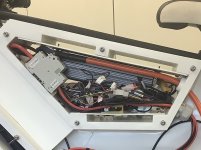If you cut the circuit right at the output of the battery casing, then there's no path for current to flow. Doesn't matter if it's B+ or B-.
If you cut the circuit at some other point in the wiring, then whatever wiring is between that point and the battery casing can still have a fault and potentially short to the other battery wiring, such as in a crash, etc. For this event, it doesn't matter if you cut both wires because that length of wiring is still vulnerable on both of them.
So cutting both B- and B+ doesn't buy you anything regardless of the point at which you do it.
You should still also have a fuse (preferably inside the battery, right at the cell block output, either B+ or B-; I use the B+), so that if anything happens that shorts wiring even at the battery case exit (crash, etc) it will blow and still protect the cells from a short that could cause a fire. (don't count on the BMS doing that in an emergency event--complicated devices can fail at the worst times, simple ones like fuses rarely do if correctly sized, placed, and installed).
The fuse should be sized for a higher current than the system will ever normally see; a direct short across the battery terminals would cause such a high current that it would blow rapidly anyway, probably before wiring/etc even noticed it was heating up.

But look at the datasheet for the fuse you want to use to make sure of that; they all have a time vs current curve to say how long it takes at a certain current before it will blow.


